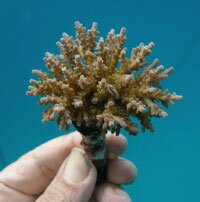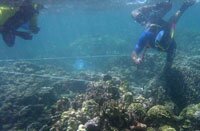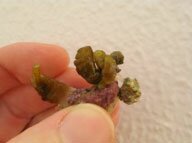With over 140 scientists from 23 countries working across six groups and four Centres of Excellence, we have many stories to tell.
 Pegs post promise in restoration
Pegs post promise in restoration
The potential of a "coral peg" for assisting reef restoration using sexually-reared corals has been demonstrated, based on results from a pilot experiment in Japan. Adopting an approach suggested at a CRTR Restoration and Remediation Working Group workshop, Japanese researchers started pilot-testing 200 pegs during June 2007.
Restoration & Remediation Working Group
Common Sampling across Centres of Excellence

The ecological sampling, or common sampling project as it is more commonly known, is designed to implement a set of key monitoring techniques to assess the dynamics of coral populations and associated coral reef organisms. The project seeks to define key ecological processes that regulate the coral populations across the CRTR's four regional Centres of Excellence, which can be replicated across the globe.
Bleaching Working Group

Searching for secret Symbiodinium
For millions of years, Brazil's coral reefs have been geographically separated from the Pacific Ocean by the Isthmus of Panama and from the Caribbean Ocean by the estuary of the Amazon River.
Bleaching Working Group
Geographical diversity of Symbiodinium
Research into the geographical diversity of Symbiodinium has found different strains in approximately 800 coral species from Zanzibar, Thailand and surrounding regions. Early results from DNA extractions, PCR-DGGE analyses and DNA sequencing of the 550 coral samples from the under-studied Thailand region indicate many new and unusual coral-algae symbioses. While a definitive assessment of how water quality affects these associations is premature, many of the same species of symbiont are being found at mainland and island locations. For more information, see Bleaching Working Group
Post-settlement bottlenecks
Coral is most vulnerable in the first year of settlement, with mortality exceeding 90% on the Mesoamerican Barrier Reef. However juvenile corals that make it through to a size refuge of about 40mm have much more promising prospects with an estimated 75% chance of long term survival. For more information: Connectivity Working Group
Impact of fish farms on coral health
Effluent from coastal fish farms has been linked to reduced water quality and increased abundances of micro-organisms in the water column. Therefore aquaculture may play a role as an incubator, conveyor and facilitator of disease into natural populations. As part of its study of the impact of local environmental factors on coral health, the DWG has found that the fish pens in Bolinao Bay (Philippines) have a strong influence on the bacteria population, nutrient input, primary production and the patterns of energy and carbon flux in the surrounding waters. For more information, see Coral Disease Working Group
ReefGame
The Modelling and Decision Support Working Group has developed the next generation of an agent-based participatory modelling game – ReefGame. A recent workshop at the Marine Science Institute’s Bolinao Marine Laboratory was attended by fishing families, barangay captains and Government officials, the novelty of the process resulted in greater sharing of ideas and experiences by the fishers compared to traditional questionnaires. For more information, see Modelling Research Group
More stories coming soon!